Key Experiment and Quantum Reasoning
Abstract
1. Intro: Beyond the Classical Horizon
2. Quantum Reasoning: The Contemporary Model of the Photon
2.1. The Dusk of Dualism
2.2. Conceptual Change to Quantum Reasoning
- Learning physics relies on conceptual understanding. It follows that misleading preconceptions or unwillingness to change a stable mindset inhibit physics learning.
- Learning quantum physics may be described as a change of reasoning not only scratching the surface but conceptually changing from classical reasoning to quantum reasoning, comparable to the changeover from the semi-classical Bohr’s model to a full quantum model [27].
- Are there further theoretical approaches to understanding, and why do commonplace difficulties in quantum physics learning arise?
2.3. Components of Quantum Reasoning
- The claim is an assertion or conclusion which addresses the problem or a phenomenon, to be explained. Quantum physical phenomena lead to quantum physical claims.
- The evidence supports the claim. It can be a set of scientific data, an observation or reading material. Thus, the evidence is always part of the real world. To support it, the evidence has to match the claim, according to the amount and quality of the data.
- The reasoning links claim and evidence, showing, why the evidence can be seen as supporting the claim, connecting the phenomena with the scientific laws and principles. Quantum claims need quantum features of reasoning.
- It is designed to be consistent with a rigorously selected list of basic exclusive quantum theoretical axioms [33].
- It is well-suited to equally footing the features of quantum mechanics (states of massive quanta) and quantum electrodynamics (states of photons).
- It links claims from the quantum domain and evidence from the real world.
- Probability thinking, where properties of physical systems are completely incorporated into the quantum states. Principally different from classical physical states quantum states are just vectors in an abstract vector space. Each vector allows for the calculation of a probability to detect (or even measure) characteristics of the system. In quantum physics, we have to think in terms of probabilities derived from quantum states. One might state that there are no physical variables in quantum physics but solely probabilities for the assignment of specific values of the variable.
- Superposition thinking focuses on the superposition principle that is a core concept of quantum theory: The linear combination of quantum states again is a quantum state. Mathematically a superposition of two quantum states, and , is nothing but the sum of these state vectors, weighted and phase shifted by specific amplitude factors, . The new quantum state of the system must be distinguished from a classical mixture of ensemble states, where probability solely occurs because our exact knowledge of the components is incomplete. In the quantum superposition each of the component states is always present. In the weighted sum, , of the substates the coefficients c1 and c2 are closely related to an internal probability without any connection to the ability of the particular scientist.
- Interference thinking focusses on the detection of the superposition of states. A polarized spin-up-state of atoms in the Stern-Gerlach apparatus confirms the superposition of a spin-up-state and a spin-down-state along the x-axis: directly measurable in the experiment. Generally, it is difficult to detect a superposition of states directly. To demonstrate a state superposition, , we are often forced to resort to demonstrating interference effects. Any phase difference between and , temporally stable during the sampling time of the detector, may lead to interference patterns. One might say that there is no quantum interference without the superposition of states and that quantum interference is a safe indicator of a superposition of quantum states.
3. Experimental Teaching in Classroom Quantum Physics
3.1. Theoretical Background
- Interpreting quantum theory is a minor part of teachers’ in- or pre-service training. Conceptual knowledge is often restricted to semiclassical concepts which ignore the basic concepts of quantum field theory, leading to the notorious problems which arise from the wave-particle dualism and localization of quanta.
- There is less information about students’ views on quantum physics when compared to those of classical physics [37].
- The lack of pre-service teacher training on the educational and experimental efforts of quantum physics [38] is significant.
- Experiments such as single-photon and two-photon interferometry and current applications in quantum physics usually go beyond experimental and theoretical high school expertise.
3.2. An Empirical Study
- How do teachers handle the problems which arise from the epistemological clash in quantum physics at school without experiments?
- How do teachers assess their pre-service education regarding the requirements of quantum physics at school?
- How can we design a teacher training program that offers university-level experimental and theoretical backgrounds suited to the real needs of teachers?
- Simulations and real (single-photon) experiments should be used in a mutually supportive manner.
- Focusing on experiments with interpretability does not depend on a formalism which goes beyond the scope of classroom mathematics.
- There should be an orientation towards principles of quantum reasoning.
3.3. A Quantum Physical Key Experiment
3.3.1. Part I: Specificities of Single Photon States
- In any case, light behaves like classical electromagnetic fields and, therefore, the amplitude of the single-photon field (whatever that might be) will also just be split at the beam splitter. Depending on the physical properties of the light used in the experiment, clicks of D3 and D4 are more or less independent, the coincidences more or less accidental. For the joint probability of coincidences compared to the product of the marginals one finds P(D3 & D4) ≥ P(D3) × P(D4) [43].
- The single-photon states of the light are made up of breakable particles. These particles behave like classical ones, and thus may burst, meaning that we have a finite probability 0<< P(D3 & D4) ≤ P(D3) × P(D4) for coincident clicks.
3.3.2. Part II: Quantum Superposition
- does not concern the splitting of anything by beam splitters,
- does not concern paths of quanta,
- tells us everything about the probabilities of detection eventualities,
- makes use of the superposition principle together with Born’s rule to explain quantum interference,
- allows us to find the quantum state prepared by a beam splitter as a nonlocal superposition of single photon substates, and
- encourages us to rename beam splitters “quantum state preparators”.
4. Impact of a Key Experiment on Quantum Reasoning
4.1. Research Goal
- 3.
- in which regard the students’ lines of argumentation move from classical reasoning (either-or) or a semiclassical dualism (as-well-as) to quantum reasoning (PSI);
- 4.
- which types of specific (quantum) reasoning (PSI; neither-nor) can be found for the explanation of quantum phenomena such as the key experiment after students had engaged with the key experiment.
4.2. Method and Sample
- Task 1: Basic understanding and description of the term photon.
- Task 2: The explanation of the absence of coincidences in the experiment with the naked beam-splitter.
- Task 3: The explanation of the counter pattern in the interferometer set up.
4.3. Analysis
4.4. Results
4.4.1. Description of a Photon
4.4.2. Beam-Splitter Experiment
4.4.3. Michelson Interferometer
4.5. Conclusions
4.6. Limitations
- The size and composition of the sample of the present test are not satisfactory for obtaining robust results which answer the research questions. However, we received strong suggestions regarding a redesign of the questionnaire (items concerning the argumentation with the superposition of states must be improved).
- Perhaps the most important limitation is the design of this study. Because of the missing control group, the observed effect cannot be attributed to the treatment without uncertainty. Thus, only evidence-based suppositions about the key experiment’s impact on students learning quantum reasoning can be derived [52]. On the other hand, one group designed studies seem to be suitable for gathering fruitful hypotheses about a treatment’s effect and can therefore be starting points for subsequent studies (see, e.g., [53]).
- Due to pandemic conditions requiring social distancing, the students had no chance to really engage with the experiment. Instead, they were reliant on a digital version of the set up. It is to be expected that the impact of the experiment was drastically lowered due to this shortcoming. For this reason, its comparability with other studies is assumed to be quite limited and thus omitted in the present paper.
- Finally, the sustainability of the effect can be assumed to be low, due to the singularity and shortness of the intervention (length ~4 h). However, the aim was to get insights into the experiment’s effect on learning quantum reasoning. Based on these results, implications can be made for teaching strategies based on key experiments, especially for gaining a more sustainable effect. More research in this field is necessary.
5. Discussion
Author Contributions
Funding
Institutional Review Board Statement
Informed Consent Statement
Data Availability Statement
Conflicts of Interest
Appendix A. Pointer Algebra of Quantum States
Appendix A.1. The Geometrical Interpretation of the Phasor q(ϕ)
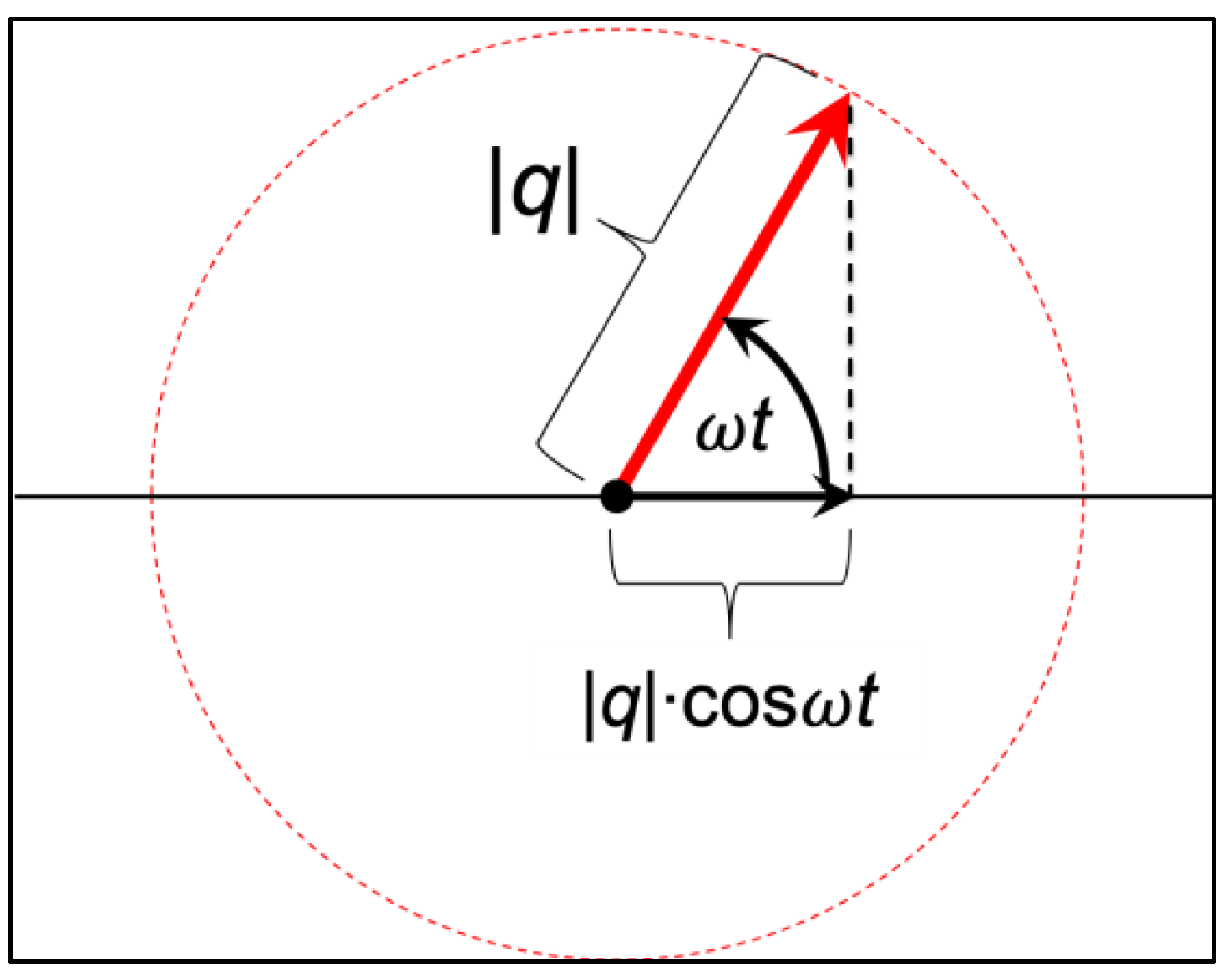
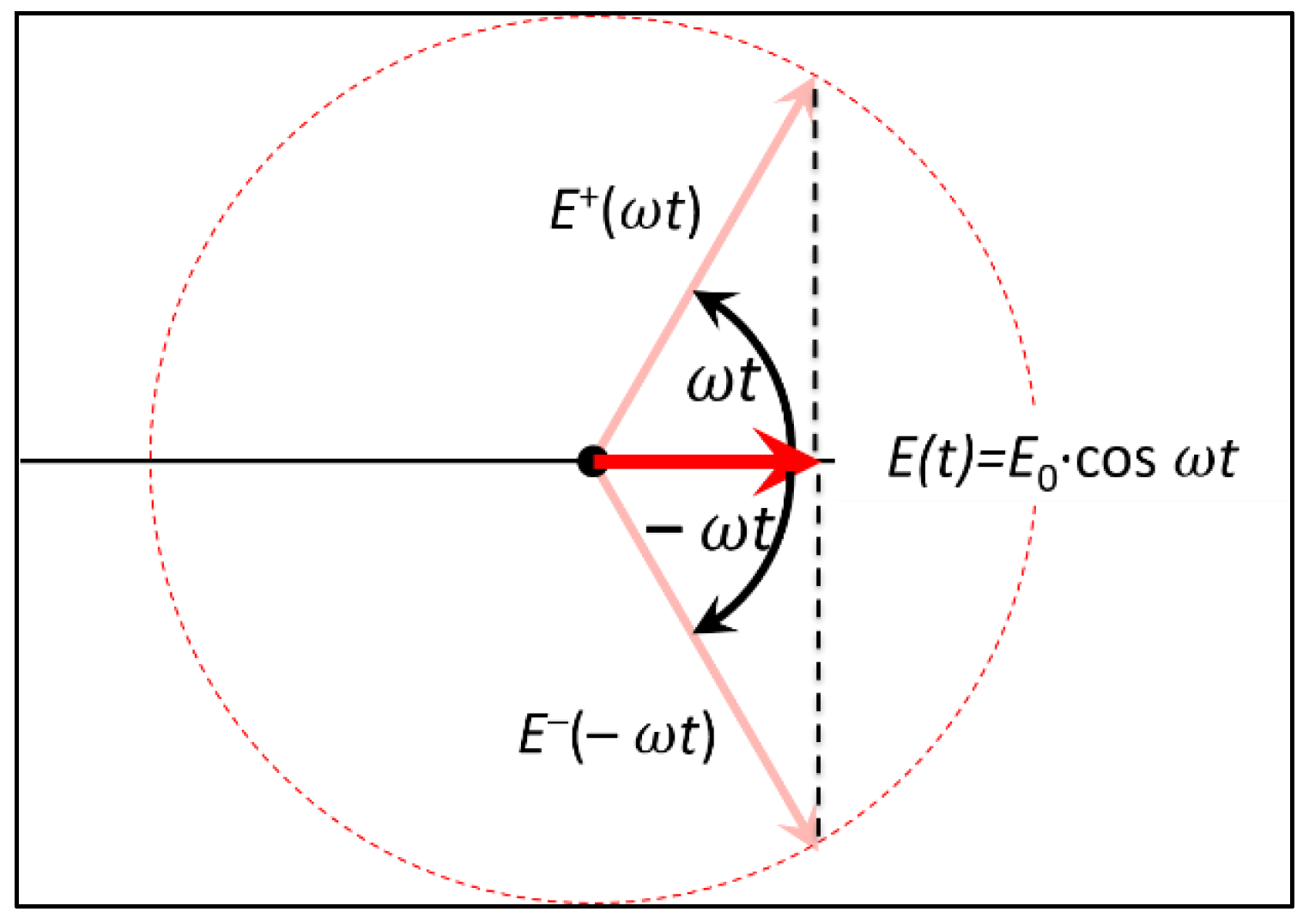

| Operation | q(ϕ)-algebra |
|---|---|
| Multiplication of q(ϕ) (geometrical interpreted as a pointer rotation) | |
| Some special values of q(ϕ) | |
| The absolute squared value | |
| The values for negative phase angles | |
| Addition of q(ϕ) |
Appendix A.2. Pointers and Quantum States
- Quantum states are represented by pointers. Positive real numbers by pointers with phase 0 (3 o’clock position) negative ones with phase π. Phases between 0 and π belong to numbers with an imaginary part.
- Here, photons are basic energy quanta populating the energy states of physical systems. The evolution of the quantum states of photons is modelled by the rotation of the pointers (Equation (A2)).
- The length of the pointer is a measure of the expected number of clicks of the detection set up (considered proportional to the number of incident photons); the phase of the state is identical to the phase angle of the pointer.
- Pointer rules (how to add and multiply them) and the calculation of the area of the square, sided by the pointer length, transform Born’s rule (see [59]) into the pointer domain.
- The pointer length corresponds to . The square area sided by the pointer length thus gives p, the probability for a de-tector click.
- The algebraic representation of the pointer is given by
Appendix A.3. Counting Single Photons−Coincident Clicks

Appendix A.4. Single Photons Interacting with Beam Splitters
Appendix A.4.1. Preparation of the Quantum States
| Operation | System State |
|---|---|
| Input: single photon state at the input mode ① | |
| Output: a superposition of the output modes ③ and ④ |
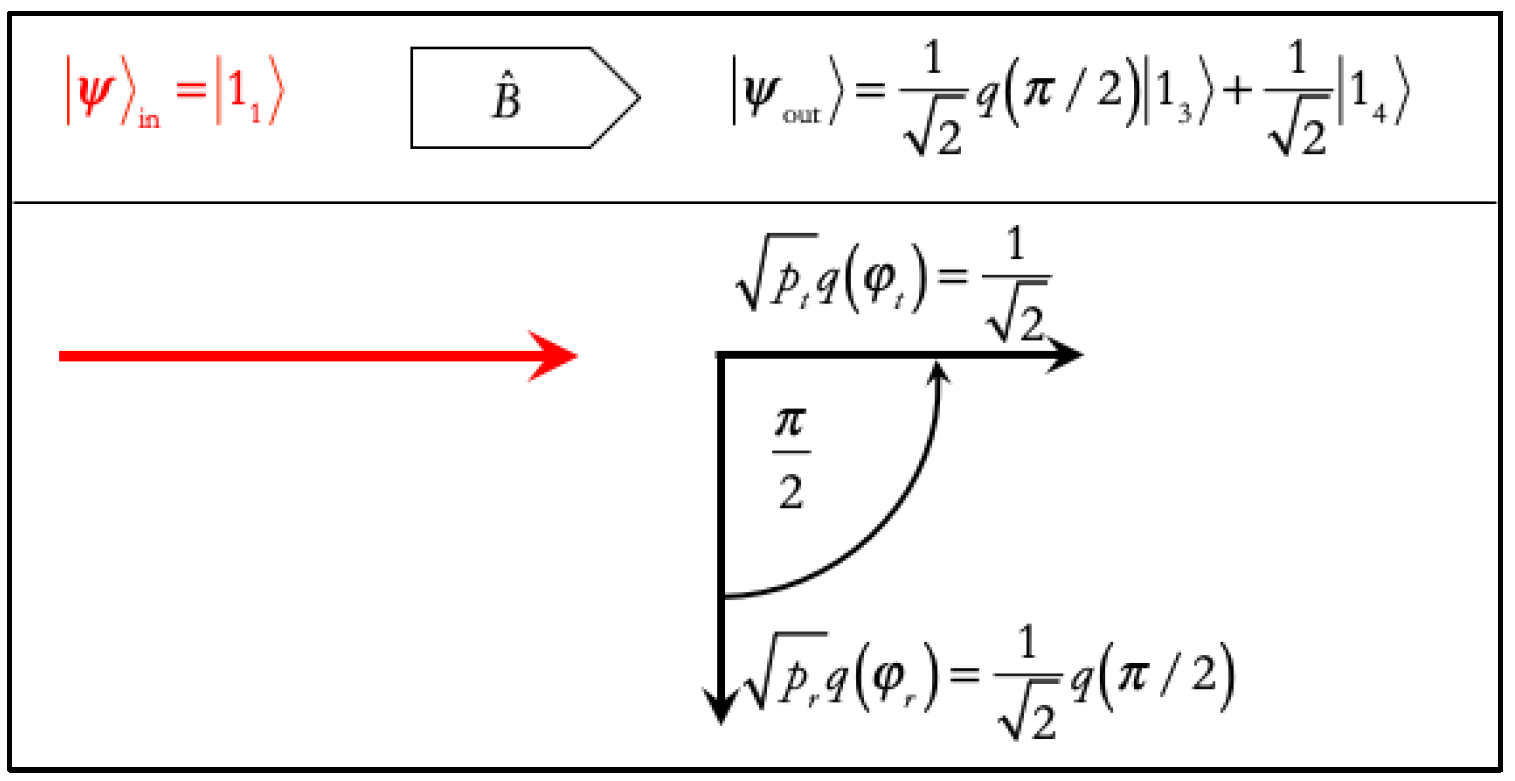
Appendix A.4.2. Detection
Appendix A.5. Single Photons Interacting with a Michelson Interferometer
Appendix A.5.1. Preparation of the Quantum States
| Operation | System State | |
|---|---|---|
| Input | ||
| Beam splitting 1-step | ||
| Phase shift ϕM due to mirror 1 and mirror 2 | ||
| Beam splitting 2-step | (A9) |
Appendix A.5.2. Detection
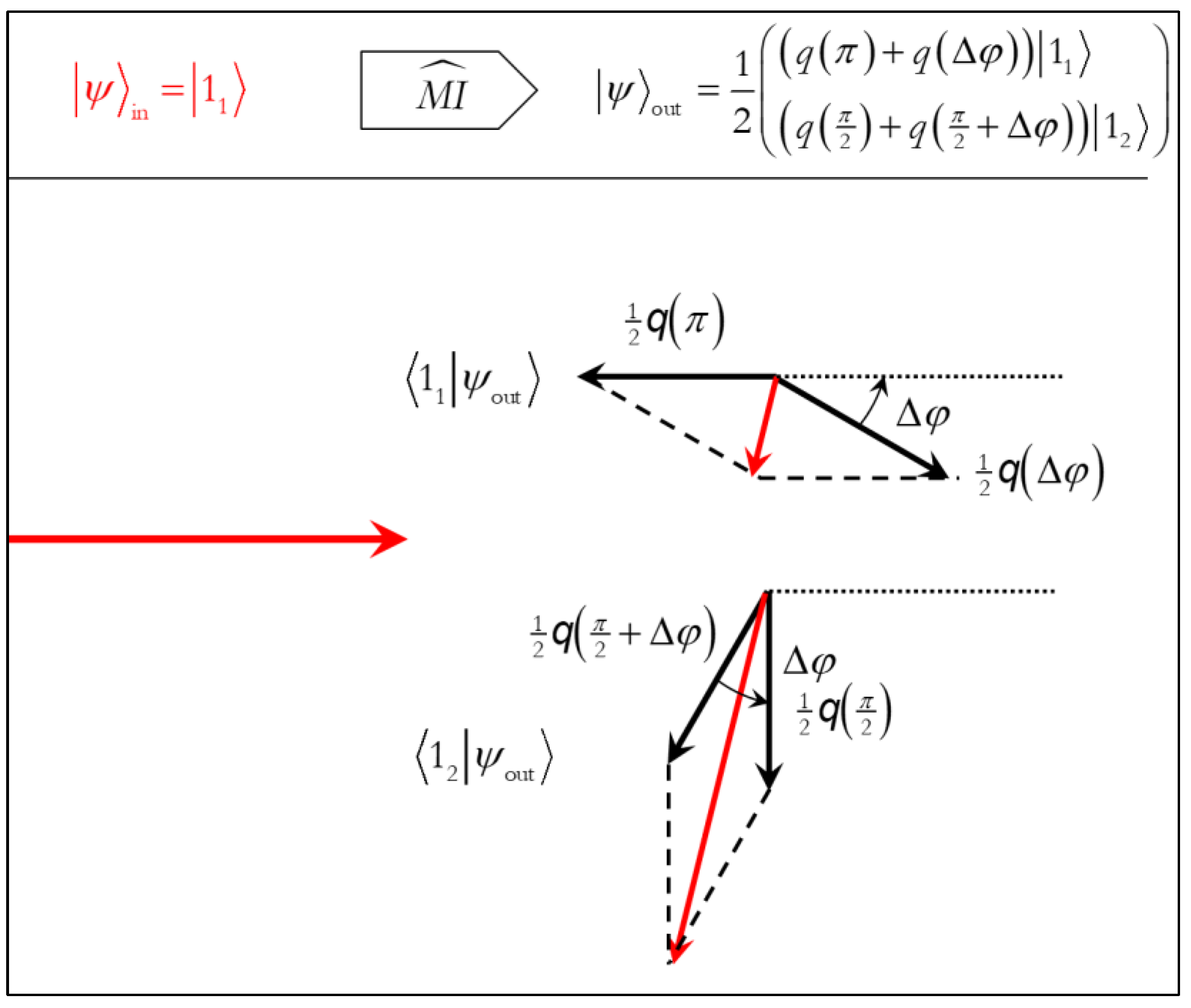
References
- Glauber, R. Coherent and incoherent states of the radiation field. Phys. Rev. 1963, 131, 2766–2788. [Google Scholar] [CrossRef]
- Koopman, L.; Brouwer, N.; Heck, A.; Buma, W.J. Remedial mathematics for quantum chemistry. J. Chem. Educ. 2008, 85, 1233–1236. [Google Scholar] [CrossRef]
- Müller, R.; Wiesner, H. Teaching quantum mechanics on an introductory level. Am. J. Phys. 2002, 70, 200–209. [Google Scholar] [CrossRef]
- Dehlinger, D.; Mitchell, M.W. Entangled photon apparatus for the undergraduate laboratory. Am. J. Phys. 2002, 70, 898–901. [Google Scholar] [CrossRef]
- Dehlinger, D.; Michtell, M.W. Entangled photons, nonlocality, and Bell inequalities in the undergraduate laboratory. Am. J. Phys. 2002, 70, 903–910. [Google Scholar] [CrossRef]
- Galvez, E.J.; Holbrow, C.H.; Pysher, M.J.; Martin, J.W.; Courtemanche, N.; Heilig, L.; Spencer, J. Interference with correlated photons: Five quantum mechanics experiments for undergraduates. Am. J. Phys. 2005, 73, 127–140. [Google Scholar] [CrossRef]
- Thorn, J.J.; Neel, M.S.; Donato, V.W.; Bergreen, G.S.; Davies, R.E.; Beck, M. Observing the quantum behaviour of light in an undergraduate laboratory. Am. J. Phys. 2004, 72, 1210–1219. [Google Scholar] [CrossRef]
- Scholz, R.; Wessnigk, S.; Weber, K.-A. A classical to quantum transition via key experiments. Eur. J. Phys. 2020, 41, 055304. [Google Scholar] [CrossRef]
- Kuhlmann, M. Interpretationen der Quantenfeldtheorie. In Philosophie der Physik.; Elsfeld, M., Ed.; Suhrkamp: Berlin, Germany, 2012. [Google Scholar]
- Bitzenbauer, P.; Meyn, J.P. A new teaching concept on quantum physics in secondary schools. Phys. Educ. 2020, 55, 055031. [Google Scholar] [CrossRef]
- Krijtenburg-Lewerissa, K.; Pol, H.J.; Brinkman, A.; van Joolingen, W.R. Insights into teaching quantum mechanics in secondary and lower undergraduate education. Phys. Rev. ST Phys. Educ. Res. 2017, 13, 010109. [Google Scholar] [CrossRef]
- Kidd, R.; Ardini, J.; Anton, A. Evolution of the modern photon. Am. J. Phys. 1989, 57, 27–35. [Google Scholar] [CrossRef]
- Muthukrishan, A.; Scully, O.M.; Zubairy, M.S. The concept of the photon—Revisited. In The Nature of Light; Roychoudhuri, C., Kracklauer, A.F., Creath, K., Eds.; CRC Press: Boca Raton, FL, USA, 2008; Chapter 4. [Google Scholar] [CrossRef]
- Hong, C.K.; Ou, Z.Y.; Mandel, L. Measurement of subpicosecond time intervals between two photons by interference. Phys. Rev. Lett. 1987, 59, 2044–2046. [Google Scholar] [CrossRef] [PubMed]
- Quantum Flagship. The future is quantum. Available online: https://qt.eu (accessed on 1 September 2022).
- Masshadi, A.; Woolnough, B. Insights into students’ understanding of quantum physics: Visualizing quantum entities. Eur. J. Phys. 1999, 20, 511–516. [Google Scholar] [CrossRef]
- Michelini, M.G.; Ragazzon, R.; Santi, L.; Stefanel, A. Proposal for quantum physics in secondary school. Phys. Educ. 2000, 35, 406–410. [Google Scholar] [CrossRef]
- Escalada, L.T.; Rebello, N.S.; Zollman, D.A. Student explorations of quantum effects in LEDs and luminescent devices. Phys. Teach. 2004, 42, 173–179. [Google Scholar] [CrossRef]
- Hoekzema, D.; van den Berg, E.; Schooten, G.; van Dijk, L. The particle/wave-in-a-boxmodel in Dutch secondary schools. Phys. Educ. 2007, 42, 391–398. [Google Scholar] [CrossRef]
- Lautesse, P.; Vila Valls, A.; Ferlin, F.; Héraud, J.L.; Chabot, H. Teaching quantum physics in upper secondary school in France. Sci. Educ. 2015, 24, 937–955. [Google Scholar] [CrossRef]
- Henriksen, E.K.; Bungum, B.; Angell, C.; Tellefsen, C.W.; Fragat, T.; Vetleseter Bøe, M. Relativity, quantum physics and philosophy in the upper secondary curriculum: Challenges, opportunities and proposed approaches. Phys. Educ. 2014, 49, 678–684. [Google Scholar] [CrossRef]
- Karakostas, V.; Hadzidaki, P. Realism vs. constructivism in contemporary physics: The impact of the debate on the understanding of quantum theory and its instructional process. Sci. Educ. 2005, 14, 607–629. [Google Scholar] [CrossRef]
- Kalkanis, G.; Hadzidaki, P.; Stavrou, D. An instructional model for a radical conceptual change towards quantum mechanics concepts. Sci. Educ. 2003, 87, 257. [Google Scholar] [CrossRef]
- Chi, M.T.H. Two kinds and Four sub-types of misconceived knowledge, ways to change it, and the learning outcomes. In International Handbook of Research on Conceptual Change; Vosniadou, S., Ed.; Routledge: New York, NY, USA; London, UK, 2013; Chapter 3; Available online: https://www.routledgehandbooks.com/doi/10.4324/9780203154472.ch3 (accessed on 1 September 2022).
- Mortimer, E.F. Conceptual change or conceptual profile change? Sci. Educ. 1995, 4, 267–285. [Google Scholar] [CrossRef]
- Waitzmann, M. Wirkung Eines Quantenoptischen Arguments auf Quantenphysikalische Argumentation. Ph.D. Thesis, Leibniz University Hannover, Hanover, Germany, 2022. [Google Scholar]
- Posner, G.J.; Strike, K.A.; Hewson, P.W.; Gertzog, W.A. Accommodation of a scientific conception: Toward a theory of conceptual change. Sc. Edu. 1982, 66, 211–227. [Google Scholar] [CrossRef]
- diSessa, A.A. Toward an epistemology of physics. Cogn. Instr. 1993, 10, 165–255. [Google Scholar] [CrossRef]
- diSessa, A.A. Conceptual change in a microcosm: Comparative learning analysis of a learning event. Hum. Dev. 2017, 60, 1–37. [Google Scholar] [CrossRef]
- McNeill, K.L.; Krajcik, J. Inquiry and scientific explanations: Helping students use evidence and reasoning. In Science as Inquiry in the Secondary Setting; Luft, J., Bell, R., Gess-Newsome, J., Eds.; NSTA Press: Arlington, VA, USA, 2008; Chapter 11. Available online: https://dpi.wi.gov/sites/default/files/imce/science/Inquiry_and_Scientific_Explanations_McNeill-Krajcik.pdf (accessed on 1 September 2022).
- Chiara, M.; Giuntini, R.; Greechie, R. Reasoning in Quantum Theory. Sharp and Unsharp Quantum Logics; Springer Science + Business Media: Dordrecht, The Netherlands, 2004. [Google Scholar] [CrossRef]
- Küblbeck, J.; Müller, R. Die Wesenszuege der Quantenphysik: Modelle, Bilder und Experimente; Aulis Verlag Duebne GmbH & Co KG: Köln, 2003; Available online: https://docplayer.org/40006159-Die-wesenszuege-der-quantenphysik-modelle-bilder-und-experimente.html (accessed on 1 September 2022).
- Friebe, C.; Kuhlmann, M.; Lyre, H.; Näger, P.; Passon, O.; Stöckler, M. Philosophie der Quantenphysik; Springer Spektrum: Beilin/Heidelberg, Germany, 2015. [Google Scholar] [CrossRef]
- Bitzenbauer, P. Effect of an introductory quantum physics course using experiments with heralded photons on preuniversity students’ conceptions about quantum physics. Phys. Rev. ST Phys. Educ. Res. 2021, 17, 020103. [Google Scholar] [CrossRef]
- Aguayo, R.; Simms, G.; Siegel, P.B. Throwing nature’s dice. Am. J. Phys. 1996, 64, 752–758. [Google Scholar] [CrossRef]
- Bronner, P.; Strunz, A.; Silberhorn, C.; Meyn, J.P. Demonstrating quantum random with single photons. Eur. J. Phys. 2009, 30, 1189–1200. [Google Scholar] [CrossRef]
- Ireson, G. The quantum understanding of pre-university physics students. Phys. Educ. 2000, 35, 15–21. [Google Scholar] [CrossRef]
- Pospiech, G.; Schöne, M. Quantenphysik in Schule und Hochschule. PhyDid B—Didaktik der Physik—Beiträge zur DPG-Frühjahrstagung. 2012. Mainz, 20.01. Available online: https://ojs.dpg-physik.de/index.php/phydid-b/article/view/392 (accessed on 1 September 2022).
- Zollman, D.A.; Rebello, N.S.; Hogg, K. Quantum mechanics for everyone: Hands-on activities integrated with technology. Am. J. Phys. 2002, 70, 252–259. [Google Scholar] [CrossRef]
- Bronner, P. Quantenoptische Experimente als Grundlage eines Curriculums zur Quantenphysik des Photons; Logos Verlag: Berlin, Germany, 2010; Available online: https://d-nb.info/100496515X (accessed on 1 September 2022).
- Häußler, P. Physikalische Bildung: Eine curriculare Delphi-Studie. Teil 1., IPN-Arbeitsbericht 41; IPN: Kiel, Germany, 1980. [Google Scholar]
- Burkard, U.E. Quantenphysik in der Schule: Bestandsaufnahme, Perspektiven und Weiterentwicklungsmöglichkeiten durch die Implementierung Eines Medienservers; Logos-Verlag: Berlin, Germany, 2009; Available online: https://www.fachportal-paedagogik.de/literatur/vollanzeige.html?FId=1057488 (accessed on 1 September 2022).
- Weber, K.-A.; Friege, G.; Scholz, R. Quantenphysik in der Schule—Was benötigen Lehrkräfte?—Ergebnisse einer Delphi-Studie. Zeit. Didaktik Natur.—ZfDN 2020, 26, 173–190. [Google Scholar] [CrossRef]
- Bitzenbauer, P.; Meyn, J.P. Fostering students‘ conception about the quantum world—Results of an interview study. Prog. Sc. Ed. 2021, 4, 40–51. [Google Scholar]
- Marshman, E.; Singh, C. Framework for understanding the patterns of student difficulties in quantum mechanics. Phys. Rev. ST Phys. Educ. Res. 2015, 11, 02011. [Google Scholar] [CrossRef]
- Ubben, M.; Heusler, S. Gestalt and functionality as independent dimensions of mental models in science. Res. Sc. Educ. 2019, 51, 1349–1363. [Google Scholar] [CrossRef]
- Kral, A.; Theis, C.; Schorn, B.; Heinke, H. Praxistauglicher Einstieg in die Quantenphysik mit Realexperimenten. In Implementation fachdidaktischer Innovation im Spiegel von Forschung und Praxis. Gesellschaft für Didaktik der Chemie und Physik Jahrestagung in Zürich 2016; Maurer, C., Ed. Universität Regensburg: Regensburg, Germany, 2017; pp. 400–404. [Google Scholar]
- Niebert, K.; Gropengießer, H. Leitfadengestützte Interviews. In Methoden in der Naturwissenschaftsdidaktischen Forschung; Krüger, D., Parchmann, I., Schecker, H., Eds.; Springer Spektrum: Heidelberg/Berlin, Germany, 2014; pp. 121–132. [Google Scholar] [CrossRef]
- Ayene, M.; Kriek, J.; Damtie, B. Wave-particle duality and uncertainty principle: Phenomenographic categories of description of tertiary physics students’ depictions. Phys. Rev. ST Phys. Educ. Res. 2011, 7, 020113. [Google Scholar] [CrossRef]
- Kuckartz, U. Qualitative Inhaltsanalyse. Methoden, Praxis, Computerunterstützung; Beltz Juventa: Weinheim, Germany, 2016. [Google Scholar]
- Schreier, M. Varianten qualitativer Inhaltsanalyse: Ein Wegweiser im Dickicht der Begrifflichkeiten [59 Absätze]. Forum Qual. Soc. Res. 2014, 15, 18. [Google Scholar] [CrossRef]
- Döring, N.; Bortz, J. Forschungsmethoden und Evaluation in den Sozial- und Humanwissenschaften; Springer: Berlin/Heidelberg, Germany, 2016. [Google Scholar] [CrossRef]
- Mannheim, E.G.; Helmes, A.; Weis, J. Tanztherapie in der stationären Onkologischen Rehabilitation. Forsch. Komplement. 2013, 20, 33–41. [Google Scholar] [CrossRef]
- Greenstein, G.; Zajonc, A.G. The Quantum Challenge; Jones and Barlett Publishers, Inc.: Sudbury, MA, USA, 1997; Available online: https://xn--webducation-dbb.com/the-quantum-challenge-pdf/ (accessed on 1 September 2022).
- Messiah, A. Quantum Mechanics; Dover Publication: New York, NY, USA, 1999. [Google Scholar]
- Filk, T. Quantenmechanik (Nicht nur) für Lehramtsstudierende; Springer Spektrum: Berlin/Heidelberg, Germany, 2019. [Google Scholar]
- Scully, M.O.; Zubairy, M.S. Quantum Optics; Cambridge University Press: Cambridge, UK, 1997. [Google Scholar] [CrossRef]
- Feynman, R.P.; Zee, A. QED: The Strange Theory of Light and Matter; Princeton University Press: Princeton, NJ, USA, 2006. [Google Scholar]
- Born, M. Zur Quantenmechanik der Stoßvorgänge. Z. Für Phys. 1926, 37, 863–867. [Google Scholar] [CrossRef]
- Loudon, R. The Quantum Theory of Light; Oxford University Press: Oxford, UK, 2000; Available online: http://rplab.ru/~as/2000%20-%20R.Loudon%20-%20The%20Quantum%20Theory%20of%20Light%20-%203rd%20ed%20Oxford%20Science%20Publications.pdf (accessed on 1 September 2022).
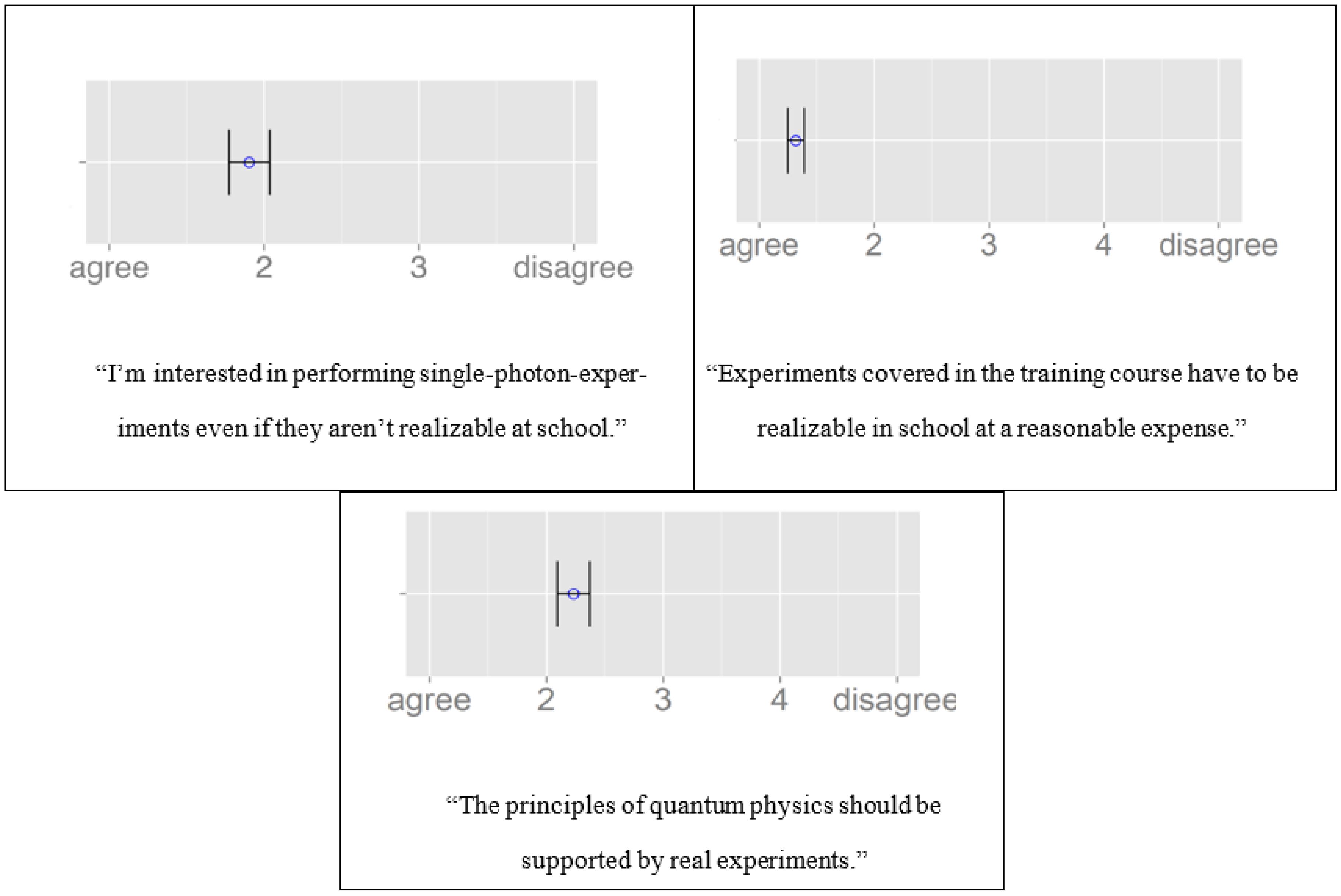
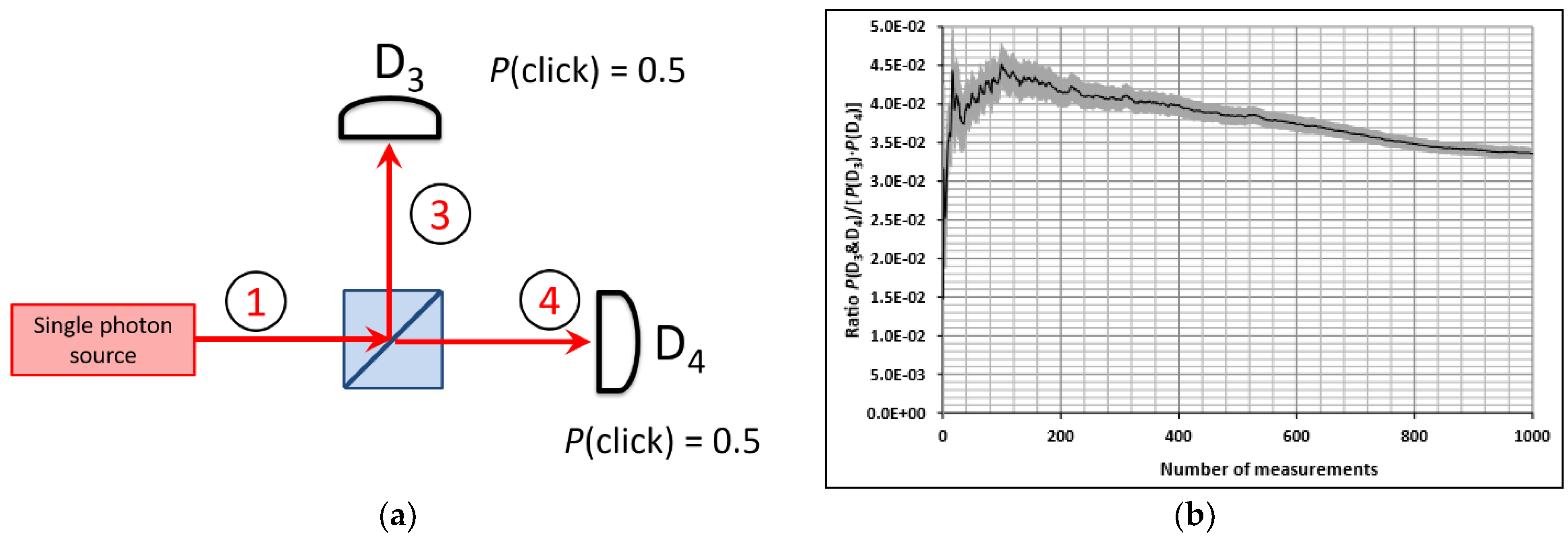
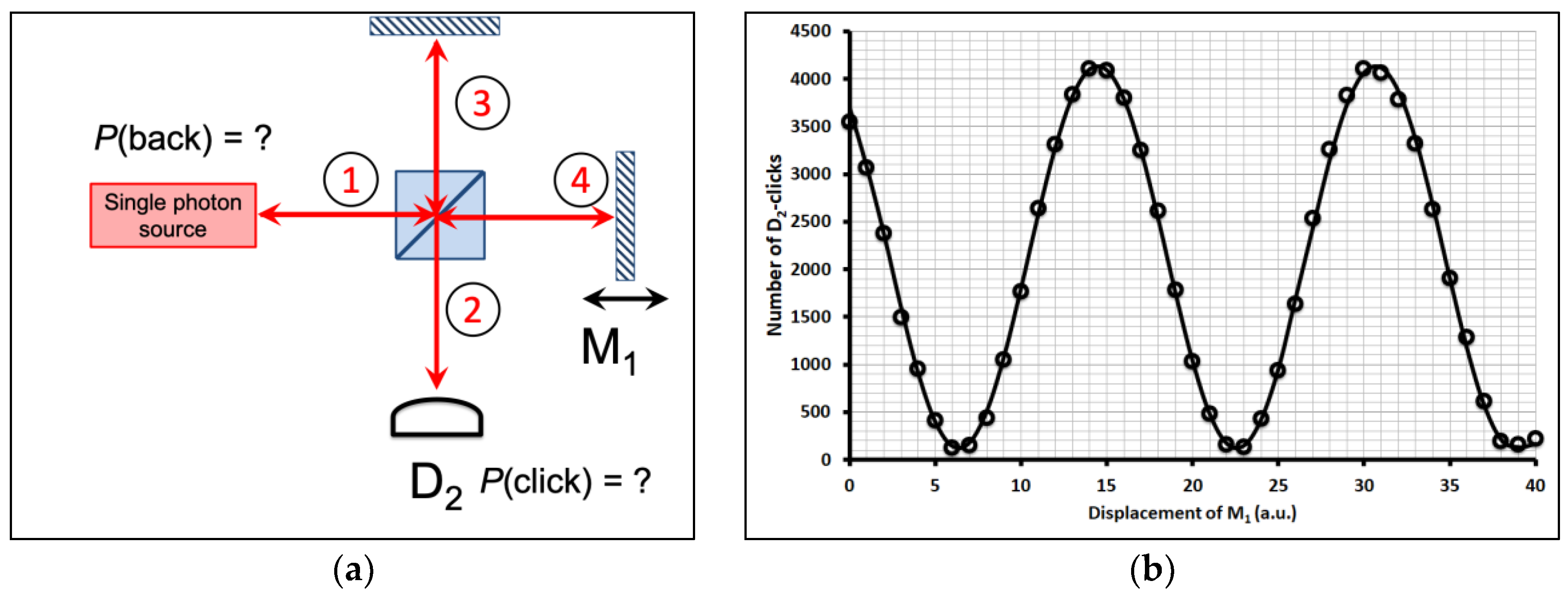
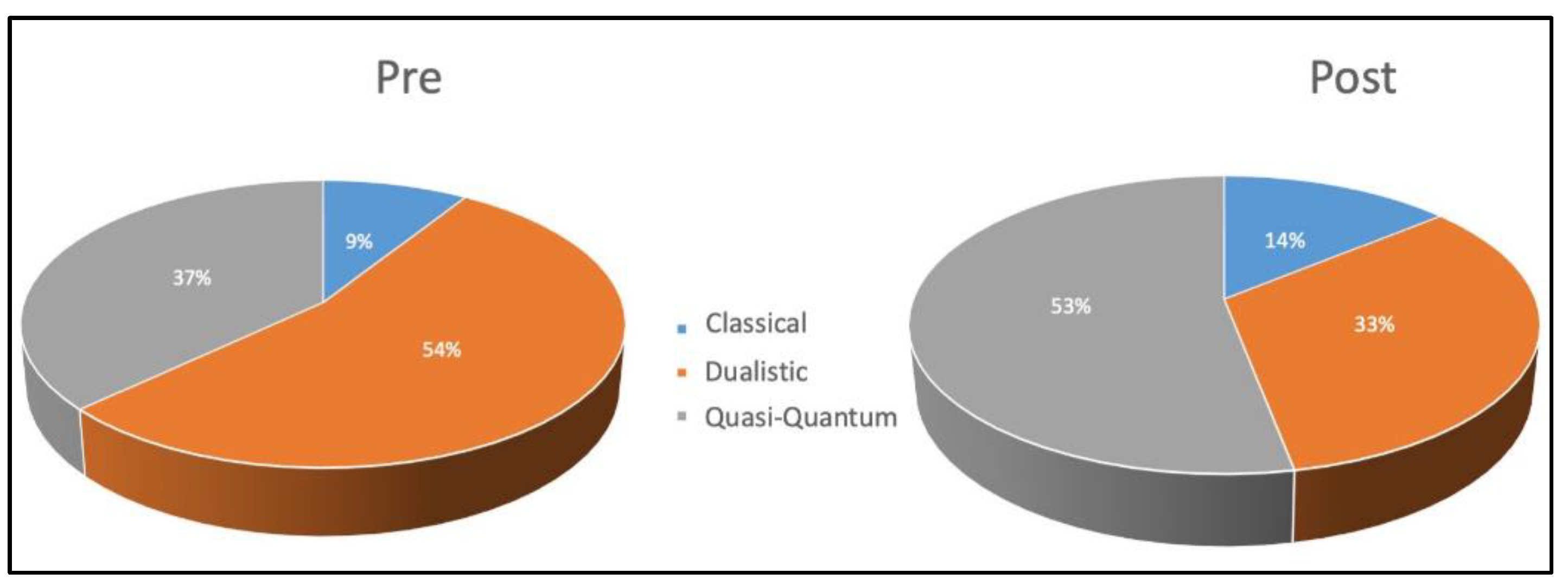
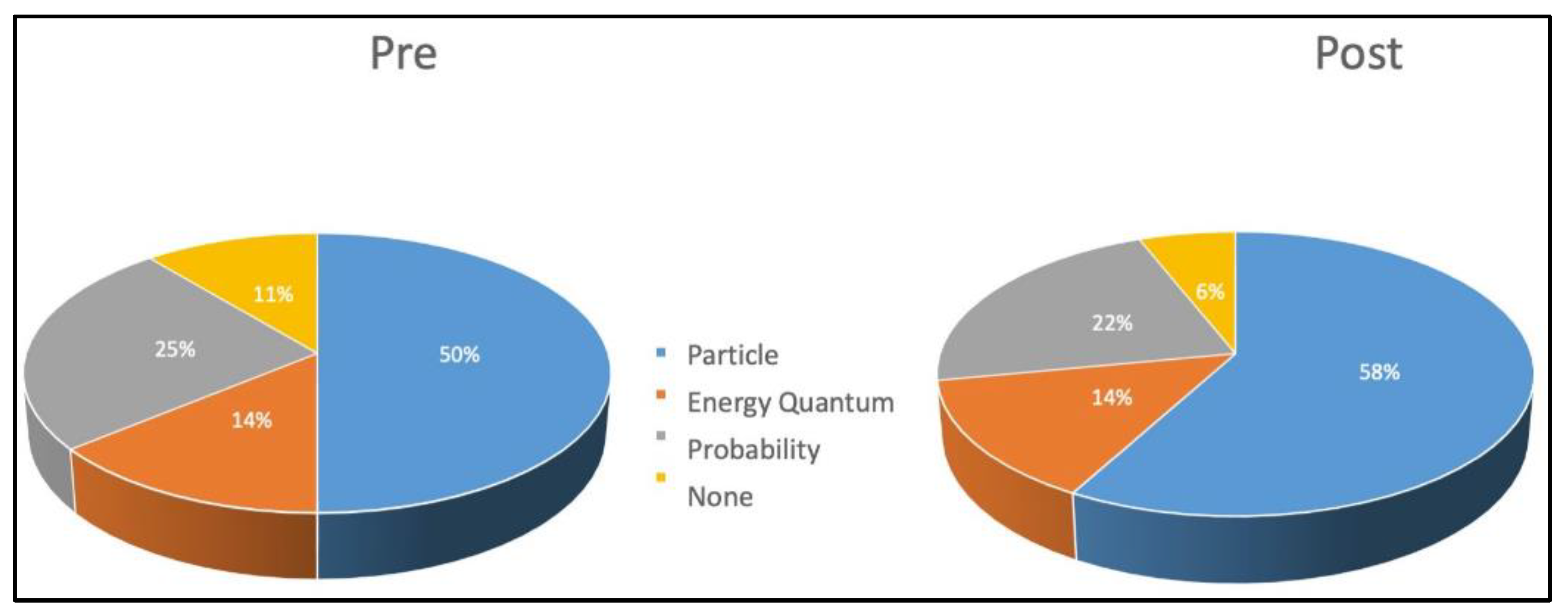

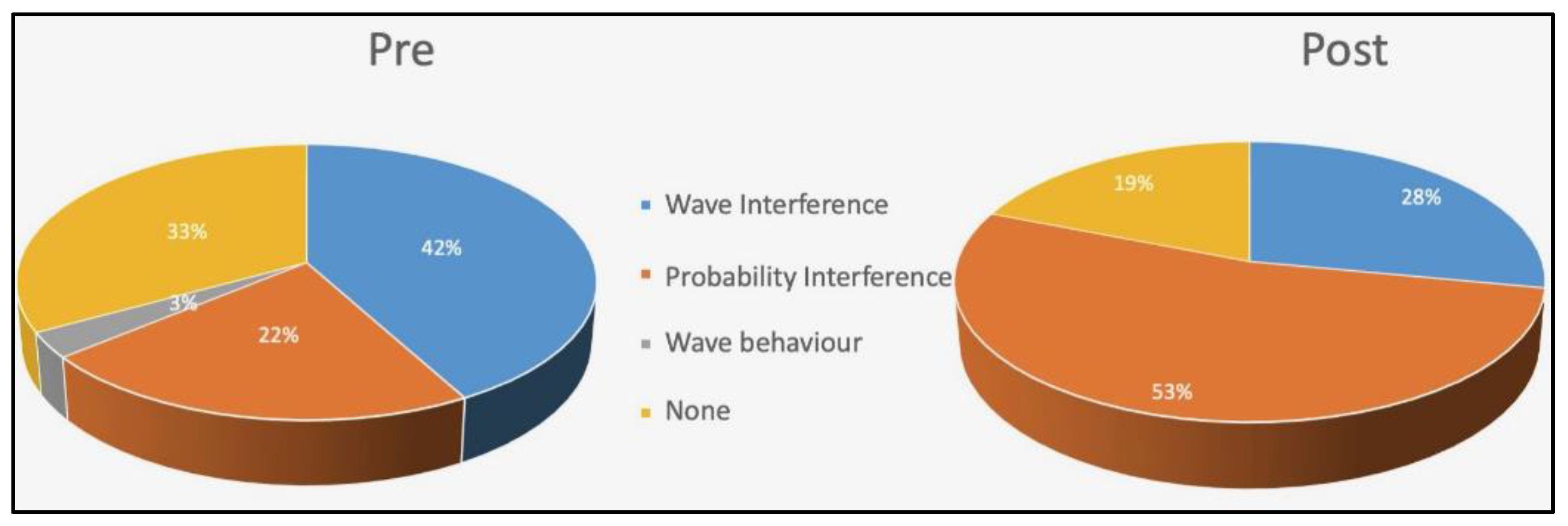
| Phenomenon | Quantum Reasoning |
|---|---|
| Interference of single photons Double slit interferometer Mach-Zehnder-Interferometer | Superposition of states |
| Born’s rule to determine the probability of an event | |
| Nonlocality of single photon states in the interferometer | |
| Blurring the interference pattern | Influence of measurement on system behaviour |
| Absence of coincidences at the optical beam splitter | Complementarity of anticorrelated events |
| Details of the Design | Example | Bundled Result |
|---|---|---|
| The questionnaire of the first round mainly consists of open questions | Which topics are challenging for your students and how do you or what do you need to master these challenges? | A typical statement: “Due to absence of experiments in school, most of principles of quantum physics can only be believed and memorized.” |
| The goal of the second round is to get access to the position of each participant to disputable answers, main attitudes and motivational topics identified in the first round. The questions are more focussed in comparison to round 1, without losing the open character to permit critical discussions. | Most of principles of quantum physics can only be believed and memorized due to absence of experiments. Please position yourself to the statement above and describe especially the role of simulations and animations. | A typical statement: “Simulations enable the discussion of the principles of quantum-physics in my class, but often my students don‘t trust in simulations.” |
| The question immediately arising asks for the generalizability of the positions identified in the first two rounds. In the third round, critical opinions and disputes from the previous two round have been identified. The group of experts have been asked to rate these on a 5-point Likert-scale | Do you agree (1), …, disagree (5)? My students do not believe in the results of computer simulations in quantum physics. | Most of the participants disagree with the position “My students don‘t trust in results from simulations.” |
| Question | Hints and Instructions | Additional Material |
|---|---|---|
| Task 1 In this interview I would like to talk with you about the photon and its behaviour. Please describe your understanding of the photon. Explain: What is youconception of photons? | What is your conception of particles/waves? | Answer options: A photon is an undividable energy quantum of the light field: 1. a light particle, which is moved by the enveloping light wave. Depending on the experimental setup, the behaviour of the photon or the light wave occurs (the classical either–or argument). 2. existing as wave and particle concurrently. Depending on the experimental setup, it occurs as a wave or as a particle (the dualistic argument). 3. neither a particle nor a wave, but it behaves sometimes similar to a wave or a particle (the quantum neither–nor argument). |
| Task 2 Single photons interacting with a beam splitter: Report the results of the experiment. Explain the results | Hints regarding relative frequency of events: What’s about features of particles? How does the result fits in with your concept of photons? What can be said about the state of the light at the output of the beam splitter? Try to give an explanation in terms of two different output modes of the beam splitter | 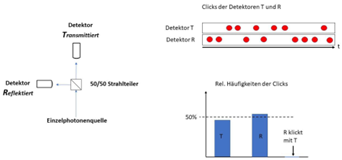 |
| Task 3 Single photons interacting with the Michelson interferometer: Report the results of the experiment Explain the results | Questioning the impact of the mirrors: What’s about features of waves? How does the result fits in with your concept of photons? What can be said about the state of the light at the screen? Try to give an explanation in terms of the superposition two different output modes of the beam splitter. | 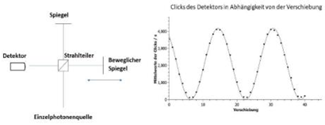 |
| Main Category | Subcategory | Description | Example | |
|---|---|---|---|---|
| Describe the term photon | Classical | The photon is described as classical particle or is associated with the properties of a classical particle | Photons are light particles, energy packages of electromagnetic radiation. Photons are portions of light (h × f), which can be modelled in different ways, but mainly it is modelled as classical particle. | |
| Dualistic | Dualistic description of photons: Hybrids of waves and particles, like for example: a wave-particle, a particle with wave properties, complementary behaviour of photons | Light is composed of photons, which are waves as well as particles. Depending on the experiment one gets the one or the other. A photon is something small, which is a wave (wavy path) as well as a particle (straight direction of propagation). The experimental setup decides which property of a photon can be observed. | ||
| Quasi-Quantum | An object which has wave like and particle like properties, but is neither a wave nor a particle; Attribution of probabilistic behaviour/probability amplitudes | A photon is an object which has properties of a wave and a particle, but is neither a wave nor a particle. A photon is a small energy package, which can’t be described by classical physics. It can be described by using probability amplitudes | ||
| Other | Cannot be categorized | Photons are positive charged particles, which work as a current of light | ||
| Optical beam splitter | Particle | Explanation of the experimental results by using particle-based reasoning | ||
| Classical | Using properties of a classical particle (e.g., realistic arguments) | In this experiment a single photon can’t be divided into two halves, because it can be at only one single position. At an optical beam-splitter, photons were reflected or transmitted with a probability of 50%, depending of the amplitude of the transporting wave. Due to particle properties, the photon can’t be divided. With a probability of 50% photons were reflected or transmitted, but they will never be divided, because the photon has to choose one path. It cannot be said anything about wave or particle properties. | ||
| Dualistic | Due to the experimental setup, the photons occur as particles. | Because the experimental setup allows to measure the photon’s location it demonstrates particle behaviour. | ||
| Quasi-Quantum | Photons behave like particles, but they are no particles | Due to the particle characteristics, the photon can’t be divided into halves like a wave. Thus, we get “either-or”-results. | ||
| Energy Quantum | Explaining the results by the indivisibility of the photon’s energy. | With a probability of 50% single photons will be transmitted or reflected at the optical beam-splitter, but neither divided in two halves, because they are indivisible energy quanta. The photon decides whether to be reflected or transmitted in probabilistic ways. | ||
| Probability | The experimental results will be explained by using a probabilistic reasoning. | |||
| Non-localisation | The experimental results need a probabilistic explanation, because the photon position is not determined until the photon’s detection. | The path taken by the photon, is unknown until the photon’s detection. However, the detection is arbitrary, with a probability of 50%. Single photons will be reflected or transmitted with a probability of 50%, but neither divided into two halves. This looks like a particle property, but the behaviour can only be described by probability amplitudes. Until the photon’s detections it is not determined whether the photon is reflected or transmitted. | ||
| (Non-localisation + superposition | Explaining the experimental results by describing the final state as a superposition of the substates reflected and transmitted. | Photons will be reflected or transmitted with a probability of 50%. Until the photon’s detection the photon’s path is not determined, but it can be described as a probability amplitude. By detecting the photon, the superposition of probability amplitudes will be destroyed. | ||
| Choice | A provided explanation is chosen by the student. | Choose Explanation1, because the photons show up as indivisibleenergy quanta. | ||
| Other | The explanation cannot be sorted into one of the categories. | No explanation, but the photons are distributed randomly. | ||
| Interferometer | Wave interference | Explaining the results like the interference of waves. | ||
| Wave characteristics | Due to the wave characteristics of photons, the interference occurs. | Interference can be observed in this experiment, because of the wave characteristics of photons. By moving the mirror, a difference in the path length is realized. Particle characteristics would lead to a constant number of counts. | ||
| Dualism | The photon shows up as a wave/the experimental setup determines the photon as a wave | Intensity minima and maxima can be observed because of the interference. Due to the superposition of wave and particle, unbreakable particles show up as waves in this experiment, because the experiment demonstrates the interference as a classical wave property. The diagram shows a sinusoidal click distribution, because the wave properties are observed in this experiment. Thus, the photon cannot be regarded as a particle/localized object. It is in a subordinated state. Depending on the superposition of the amplitudes, constructive or destructive interference can be observed. It becomes understandable, how the photon’s properties are determined by the experimental setup. | ||
| Probability interference | The observed interference is a probability interference. | |||
| Non-localisation | A probability interference is observed, because the photon’s position cannot be determined. → Basic probabilistic reasoning | In this experiment constructive and destructive interference can be observed, because reflected or transmitted photon 50% probability is reflected on the beam-splitter again, by the mirrors. Thus, it is impossible to determine whether the photon is reflected or transmitted and probabilities will interfere. This experiment demonstrates a wave characteristic. | ||
| Superposition of probability amplitudes | The photon must be described by probability amplitudes and the superposition of the probability amplitudes causes the interference. → Advanced probabilistic reasoning | In this experiment the probability amplitudes of the both, possible paths the photon could take, are superimposed. By moving the mirror, a difference in the paths is realized and the inference pattern changes from constructive to destructive interference of the probability. Thus, a wave characteristic is attributed to the photon. In this experiment constructive and destructive interference can be observed, because the probability distributions of the both possibilities interfere. For each possibility, reflection or transmission, a probability distribution exists, which can be regarded as waves in the arms of the interferometer. Thus, by moving the mirror a phase difference is created. | ||
| Wave behaviour | The experiment demonstrates the photon’s wave properties but no interference | More or less photons are detected, because depending on the distance between mirror and beam-splitter more or less photons can be registered. This must be the wave property, because a particle will be detected with a property of 50%. | ||
| Other | The explanation cannot be categorized. | Not an explanation, but the chose option 2 or 3. The experiment allows no opportunity to talk about the indivisibility, because it can’t be measured whether the photon is reflected or transmitted. And the energy of the photon changes by increasing the distance between beam-splitter and mirror, due to air friction. | ||
| No explanation | Student choose an option without any further explanation. |
Publisher’s Note: MDPI stays neutral with regard to jurisdictional claims in published maps and institutional affiliations. |
© 2022 by the authors. Licensee MDPI, Basel, Switzerland. This article is an open access article distributed under the terms and conditions of the Creative Commons Attribution (CC BY) license (https://creativecommons.org/licenses/by/4.0/).
Share and Cite
Waitzmann, M.; Weber, K.-A.; Wessnigk, S.; Scholz, R. Key Experiment and Quantum Reasoning. Physics 2022, 4, 1202-1229. https://doi.org/10.3390/physics4040078
Waitzmann M, Weber K-A, Wessnigk S, Scholz R. Key Experiment and Quantum Reasoning. Physics. 2022; 4(4):1202-1229. https://doi.org/10.3390/physics4040078
Chicago/Turabian StyleWaitzmann, Moritz, Kim-Alessandro Weber, Susanne Wessnigk, and Ruediger Scholz. 2022. "Key Experiment and Quantum Reasoning" Physics 4, no. 4: 1202-1229. https://doi.org/10.3390/physics4040078
APA StyleWaitzmann, M., Weber, K.-A., Wessnigk, S., & Scholz, R. (2022). Key Experiment and Quantum Reasoning. Physics, 4(4), 1202-1229. https://doi.org/10.3390/physics4040078





